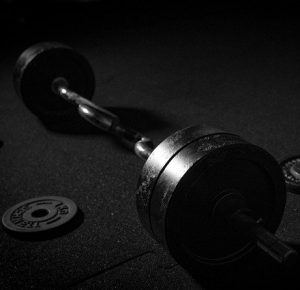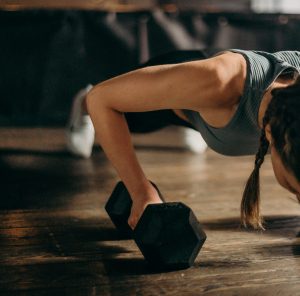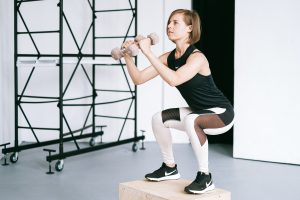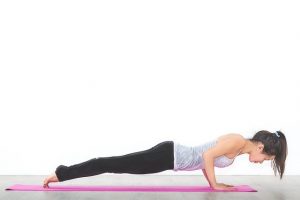 The cardio and respiratory systems ( The Body and Exercise ) are the basis of your physical fitness, the stronger your systems are the better your basic fitness and the higher level of fitness you can achieve. By having a good level of cardio and respiratory fitness and adding to this base resistance exercises will increase your overall fitness and strength and should be included in your workout.
The cardio and respiratory systems ( The Body and Exercise ) are the basis of your physical fitness, the stronger your systems are the better your basic fitness and the higher level of fitness you can achieve. By having a good level of cardio and respiratory fitness and adding to this base resistance exercises will increase your overall fitness and strength and should be included in your workout.
Whether you use weights or not you can still have a strength and conditioning workout. In addition to a running & or cycling program the conditioning workout will strengthen your whole body particularly the upper body and add strength to your cardio fitness training as well as giving a complete full body program .
Dumbbells are ideal pieces of equipment for indoor fitness and adds a variety of alternative exercises without taking up too much additional space.
Depending on your level of fitness, strength level and how recently you have had a workout will guide you with your decision which dumbbell weight you are starting with. Please note you can even start your fitness plan with yoga, pilates and or calesthentics including pushups, sit ups and squats to name a few alternative exercises and than introduce the weights as you get stronger to keep building your strength. It`s always better to err on the side of caution when starting a new program or even new exercises so start lighter and build up. For the beginner unless you are intending to have an extensive range of weights available at home than a couple of dumbbell sets from maybe 1kg to 5 kg and a 10kg set should get you under way keeping in mind these weights are for conditioning which will tone your body, give you some definition but not bulk. As you gain strength you can add heavier weights or simply increase the repetitions and the number of exercises will help keep you improving.
If you aim to build bulk and/or achieve higher levels of strength than you will need an extensive range of weights, a bench with a bench press stand or alternatively go full out with a complete Multi Station Home Gym which come with a range of stations to suit your budget and space available.
Conditioning Workout.
As a suggestion here are 4 exercises with variations and the corresponding muscle groups used in those exercises. When introducing new exercises to your workout test the exercise first for correct technique, number of starting reps or weight. Any pain or discomfort maybe caused by bad technique, an underlying (injury) problem or increasing the difficulty of the exercise too quickly.

1.The PUSH UP for your Chest or Pectoralis Muscles, deltoids or shoulders and triceps. Lying in a prone position hands and feet on the ground and with arms straight, keeping your body ridged hands slightly more than shoulder width apart and with feet together than lower your chest to the ground and pushup back to the start position by straightening your arms. First off see how many you can do than set some goals and break the number down to 3 sets of 5-10 reps and increase from there. As you improve increase the difficulty by raising your feet and/or move your hand position back towards your hips. Another option is to have dumbbells in each hand increasing the drop from the ground than lower your chest to the ground. For more explosive work as you pushup jump with your hands working towards total lift off until you can clap hands between reps.
If you are having trouble starting any pushups keep your knees on the the ground or alternatively stand up straight leaning at an angle and do pushups onto a bench or table top with feet on the ground, the more upright you are the easier it is than you can increase the difficulty and progress from there.
A reverse pushup is a good exercise to work the antagonist (opposite ) muscles to the pushup which are the back muscles and triceps but also includes the chest, shoulders and core muscles. While sitting on the floor, legs bent, feet on the floor, hands positioned below your shoulders fingers pointing towards your feet pushup than raise your hips so your back is straight and your body is parallel with the floor (legs still bent) than lower your hips to an almost sitting position and repeat. Another variation is the dip exercise where your hands are positioned behind your back on a stool or bench, feet on the floor, legs bent and you lower yourself to the floor and repeat.
2.The SQUAT, primary muscles used are the hamstrings, glutes, calves, lower, middle and upper back. Your feet should be shoulder width apart and with your back straight lower your buttocks so your thighs are at 90 degrees to your lower leg and repeat 3 sets of 5-10 reps. To increase the difficulty either hold dumbbell weights and/or rise sharply raising your heals, than progress to a mini jump than a higher jump. Note you can squat lower as well depending on your ankle and knee flexibility and a complete squat where your buttocks nearly reaches the floor is a good goal to progress too.
An other variation of the squat is the dead lift using a bar (with weights), dumbbells or Kettlebells. Usually this exercise incorporates a heavier weight incorporating not only the core muscles, the Gluteus Maximus ( largest muscle of the body) the quadriceps, hamstrings, calves and back muscles but in addition shoulders and forearms are used with the dead lift. Technique is very important when exercising especially when lifting heavy weights so if considering the dead lift you need to review your technique and flexibility so when starting as with a simple squat bend your legs to 90 degrees at the knee joint and raise your heels slightly which takes pressure off your ankles including the achilles tendon.
other variation of the squat is the dead lift using a bar (with weights), dumbbells or Kettlebells. Usually this exercise incorporates a heavier weight incorporating not only the core muscles, the Gluteus Maximus ( largest muscle of the body) the quadriceps, hamstrings, calves and back muscles but in addition shoulders and forearms are used with the dead lift. Technique is very important when exercising especially when lifting heavy weights so if considering the dead lift you need to review your technique and flexibility so when starting as with a simple squat bend your legs to 90 degrees at the knee joint and raise your heels slightly which takes pressure off your ankles including the achilles tendon.
The LUNGE. The muscles involved are all the leg muscles, glutes, lower back and stomach and the joints involved are the ankle, knee and hips. From standing in an upright position, feet shoulder width apart, hands on hips, take a step forward keeping your foot on the ground bending your leg to 90 degrees at your knee joint, keep your back straight, head up and maintaining balance with no rotation of the torso and do not move your knee forward past your ankle . The lower leg ( Tibia and fibula ) should be at right angles to the ground. Push back to a standing upright position feet shoulder width apart. starting with 3 sets of 5-10 reps. To increase difficulty hold a weight in your hands with either dumbbells, a barbell or even a medicine ball.
3.The SIT UP and the AB WHEEL are great for Abdominal or stomach muscles strength but also for hip strength and flexibility, low back flexibility, spinal and shoulder stability. Muscles involved besides all the abdominal`s are the thigh (vastus Lateralis , tensor fasciae latae) and upper thigh muscles (rectus femoris, iliacus, iliopsas ) and additional muscles with the AB wheel are Pectoralis muscles, triceps, biceps and radialis muscles  incorporating the chest and arms. For sit ups lie face up on the floor legs bent support your feet under a bench if necessary lift to a sitting position keeping your spine straight so your head does not lean forward and repeat 3 sets of 5-10 reps to start with. Some alternative stomach exercises .1. lie on your back ( if necessary secure your hands ) and with legs straight bring your knees to your chest than straighten legs again. .2. Lie on your back and with legs straight do scissors .3. Sit upright on the floor bring knees arm length to chest and with hands together touch the floor on each side turning the torso facing your hands ( 3 sets of 10 reps ).
incorporating the chest and arms. For sit ups lie face up on the floor legs bent support your feet under a bench if necessary lift to a sitting position keeping your spine straight so your head does not lean forward and repeat 3 sets of 5-10 reps to start with. Some alternative stomach exercises .1. lie on your back ( if necessary secure your hands ) and with legs straight bring your knees to your chest than straighten legs again. .2. Lie on your back and with legs straight do scissors .3. Sit upright on the floor bring knees arm length to chest and with hands together touch the floor on each side turning the torso facing your hands ( 3 sets of 10 reps ).
For advanced stomach work incorporate an AB Wheel where you kneel down or legs straight with hands on the wheel inhale, extend arms forward so your torso is parallel to the floor exhale and return to the start position. You may find this difficult so gradually build up. An Exercise Ball can replace the AB wheel. There are many exercises for abdominals and back muscles including with Isometric exercises which are contractions of a particular muscle or group of muscles where the muscle doesn`t noticeably lengthen and the affected joint does not move. Planking for example (see picture) is great isometric exercise when starting and as a good gauge as you develop your strength to show your improvement. With reference to planking (or pushups) an alternative to having your feet on the ground is to raise your feet with a stool or chair and have arms straight which will increase the difficulty ( For more exercise variations check the book Anatomy of Strength Training by Pat Manocchia ). Also the Back Mechanic and Ultimate Back Fitness and Performance by Professor Stuart McGill are great reads and may assist if you have injuries as well.
4.The CHIN UP and Pull Ups. Muscles in use with the Chin Up are the biceps, chest and and to a lesser extent the shoulders and back area while the joints involved are the shoulder, elbow and wrist. The hands are positioned slightly wider than shoulder width apart with the palms facing you. For the Pull Up position your palms away from you and this changes the muscles used so that the back, shoulders and triceps are targeted more. The joints involved are the same as for chin ups. There is nowhere to hide with these exercises, just you and your body weight so whatever you can manage just do them regularly (even a small number of reps but more often) also standing on an elastic band will help when starting as increasing may be difficult so keep at it.
For chin ups & pull ups you can purchase a simple adjustable pull up bar is inexpensive and fits within a doorway frame and as long as you can position it at a suitable height the bar is totally adequate, otherwise a pull up bar frame can mount on a wall or over a doorway (again at a suitable height ) is another option. Alternatively the next choice is a free standing frame with 1 or more stations for different exercises including chin ups, dips, pushups and leg raises or finally a multi station home gym which have an allocated bar for chin ups plus various other workout stations but these are more elaborate, a lot more expensive and take up more space.
Dips and bent over rows are good exercises to assist building strength in your arms, chest, shoulders and back giving strength for improving the chin ups and pull ups. As mentioned the bent over row with dumbbells or a weighted bar will strengthen your arms, back and shoulders if you can`t access a pull up bar and these are alternative replacement exercises for chin ups but just make sure you have a good technique keeping your back straight as you bend from the hips, legs slightly bent and pull the weight to your chest.
A suggestion when starting a fitness program is to pick several exercises to form a circuit with 5-10 reps of each, see how long it takes to complete one circuit/set ( or several sets ) of your exercises incorporating the 5 – 10 reps and stick to that time frame than as you improve work a bit faster to fit in more reps into that time frame and so increasing the difficulty and your fitness level.
4 Specific Core exercises to get you going.
Check out this video for a more advanced dumbbell workout